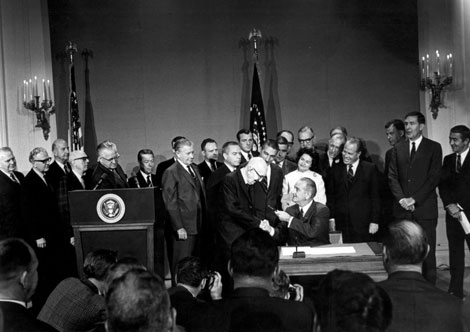

 The Central Arizona Project was authorized on September 30, 1968, as part of the Colorado River Basin Project Act, Public Law 90-537 (82 Stat. 885). While "Title V– Upper Colorado River Basin: Authorization and Reimbursements," provided for construction of Animas-La Plata, Dolores, Dallas Creek, West Divide, San Miguel, and Central Utah (Unitah Unit) Projects, CRBP was largely legislation that actualized the long pursued dream of diverting Colorado River water to central Arizona. In this photo, President Lyndon Johnson signs the legislation, handing a pen to Senator Carl T. Hayden, who had been influential in getting the legislation passed. Reclamation Photograph.
The Central Arizona Project was authorized on September 30, 1968, as part of the Colorado River Basin Project Act, Public Law 90-537 (82 Stat. 885). While "Title V– Upper Colorado River Basin: Authorization and Reimbursements," provided for construction of Animas-La Plata, Dolores, Dallas Creek, West Divide, San Miguel, and Central Utah (Unitah Unit) Projects, CRBP was largely legislation that actualized the long pursued dream of diverting Colorado River water to central Arizona. In this photo, President Lyndon Johnson signs the legislation, handing a pen to Senator Carl T. Hayden, who had been influential in getting the legislation passed. Reclamation Photograph.For more information on Senator Hayden: http://bioguide.congress.gov/scripts/biodisplay.pl?index=H000385
The Central Arizona Project was authorized for construction under the Colorado River Basin Project Act, Public Law 90-537 (82 Stat. 885), approved September 30, 1968.
This was the culmination of a process that began with formal investigations started in 1944 by the Phoenix Development Office. The Central Arizona Project report was published as House document No. 136, 81st Congress, 1st session, and was recommended for authorization in 1949.
During the 1950s, investigations for the project were halted while the Supreme Court heard the issue of lower Colorado River water rights in the case of Arizona v. California. In 1961, when it appeared a Supreme Court decision favorable to Arizona might be imminent, the Phoenix Development Office reopened investigations, using funds provided by the States of Arizona and New Mexico.
The resulting report, dated January 1962, documented the major changes that had taken place since the initial report. Continuous investigations through authorization provided data for reports on this project in 1964, 1967, and 1968.
